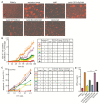A Novel Bispecific Antibody for EpCAM-Directed Inhibition of the CD73/Adenosine Immune Checkpoint in Ovarian Cancer
- PMID: 37509310
- PMCID: PMC10378099
- DOI: 10.3390/cancers15143651
A Novel Bispecific Antibody for EpCAM-Directed Inhibition of the CD73/Adenosine Immune Checkpoint in Ovarian Cancer
Abstract
PD-1/PD-L1-inhibiting antibodies have shown disappointing efficacy in patients with refractory ovarian cancer (OC). Apparently, OC cells exploit nonoverlapping immunosuppressive mechanisms to evade the immune system. In this respect, the CD73-adenosine inhibitory immune checkpoint is of particular interest, as it rapidly converts pro-inflammatory ATP released from cancer cells to immunosuppressive adenosine (ADO). Moreover, cancer-cell-produced ADO is known to form a highly immunosuppressive extra-tumoral 'halo' that chronically inhibits the anticancer activity of various immune effector cells. Thus far, conventional CD73-blocking antibodies such as oleclumab show limited clinical efficacy, probably due to the fact that it indiscriminately binds to and blocks CD73 on a massive surplus of normal cells. To address this issue, we constructed a novel bispecific antibody (bsAb) CD73xEpCAM that inhibits CD73 expressed on the OC cell surface in an EpCAM-directed manner. Importantly, bsAb CD73xEpCAM showed potent capacity to inhibit the CD73 enzyme activity in an EpCAM-directed manner and restore the cytotoxic activity of ADO-suppressed anticancer T cells. Additionally, treatment with bsAb CD73xEpCAM potently inhibited the proliferative capacity of OC cells and enhanced their sensitivity to cisplatin, doxorubicin, 5FU, and ionizing radiation. BsAb CD73xEpCAM may be useful in the development of tumor-directed immunotherapeutic approaches to overcome the CD73-mediated immunosuppression in patients with refractory OC.
Keywords: CD73; EpCAM; adenosine; bispecific antibody; ovarian cancer.
Conflict of interest statement
The authors declare no conflict of interest.
Figures





Similar articles
-
Bispecific antibody CD73xEGFR more selectively inhibits the CD73/adenosine immune checkpoint on cancer cells and concurrently counteracts pro-oncogenic activities of CD73 and EGFR.J Immunother Cancer. 2023 Sep;11(9):e006837. doi: 10.1136/jitc-2023-006837. J Immunother Cancer. 2023. PMID: 37734877 Free PMC article.
-
Bispecific antibody CD73xEpCAM selectively inhibits the adenosine-mediated immunosuppressive activity of carcinoma-derived extracellular vesicles.Cancer Lett. 2021 Aug 28;521:109-118. doi: 10.1016/j.canlet.2021.08.037. Online ahead of print. Cancer Lett. 2021. PMID: 34464670
-
Targeting two distinct epitopes on human CD73 with a bispecific antibody improves anticancer activity.J Immunother Cancer. 2022 Sep;10(9):e004554. doi: 10.1136/jitc-2022-004554. J Immunother Cancer. 2022. PMID: 36096528 Free PMC article.
-
The Multifaceted Actions of CD73 During Development and Suppressive Actions of Regulatory T Cells.Front Immunol. 2022 May 31;13:914799. doi: 10.3389/fimmu.2022.914799. eCollection 2022. Front Immunol. 2022. PMID: 35711418 Free PMC article. Review.
-
CD73/adenosine dynamics in treatment-induced pneumonitis: balancing efficacy with risks of adverse events in combined radio-immunotherapies.Front Cell Dev Biol. 2025 Jan 13;12:1471072. doi: 10.3389/fcell.2024.1471072. eCollection 2024. Front Cell Dev Biol. 2025. PMID: 39872847 Free PMC article. Review.
References
-
- Gainor J.F., Shaw A.T., Sequist L.V., Fu X., Azzoli C.G., Piotrowska Z., Huynh T.G., Zhao L., Fulton L., Schultz K.R., et al. EGFR Mutations and ALK Rearrangements Are Associated with Low Response Rates to PD-1 Pathway Blockade in Non-Small Cell Lung Cancer: A Retrospective Analysis. Clin. Cancer Res. 2016;22:4585–4593. doi: 10.1158/1078-0432.CCR-15-3101. - DOI - PMC - PubMed
Grants and funding
LinkOut - more resources
Full Text Sources
Research Materials
Miscellaneous

